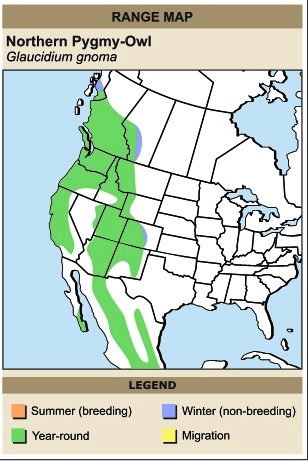|
Small owl, upperparts
and sides range from brown to white-spotted
gray-brown or gray. White underparts have brown stripes. Head is brown
or gray with white spots; no ear tufts. Yellow eyes have white eyebrows.
White-bordered black spots on back of head resemble a pair of eyes.

|
NORTHERN
PYGMY OWL
Glaucidium gnoma
STRIGIFORMES
True Owls (Strigidae)
Range and Habitat
Northern Pygmy-Owl: Resident on the Pacific coast from southern Alaska
to Central America; also found in the Rocky Mountains. Preferred habitats
include open coniferous and mixed forests, open fields, wetlands, and
logged areas.
SOUND: "too-too too"
The Northern Pygmy-Owl has also been called Pygmy Owl, Rocky Mountain
Pygmy Owl, Vancouver Pygmy Owl, California Pygmy Owl, and Dwarf Owl.
They can carry prey weighing more than twice their own weight. They
often eat only the brains of birds and the soft
abdomen of insects.
Unlike other North American owls, they begin incubation only after their
clutch is complete, so the young tend to hatch over a period of 1 to
2 days, rather than one every 1 to 2 days.
A group of owls has many collective nouns, including a "bazaar",
"glaring", "parliament", "stooping", and
"wisdom" of owls.
The Northern Pygmy-Owl has a large range, encompassing Guatemala, Honduras,
Canada, the United States, and Mexico. This bird prefers subtropical
or tropical forest ecosystems as well as dry savannas and permanent
freshwater lakes. The global population of this bird is unknown, as
it was not recognized by the IUCN until recently, but does not show
signs of decline
that would necessitate inclusion on the IUCN Red List.
For this reason, the current evaluation status of the Northern Pygmy-Owl
is Least Concern.

|